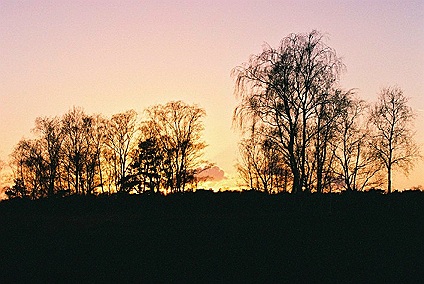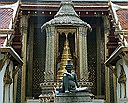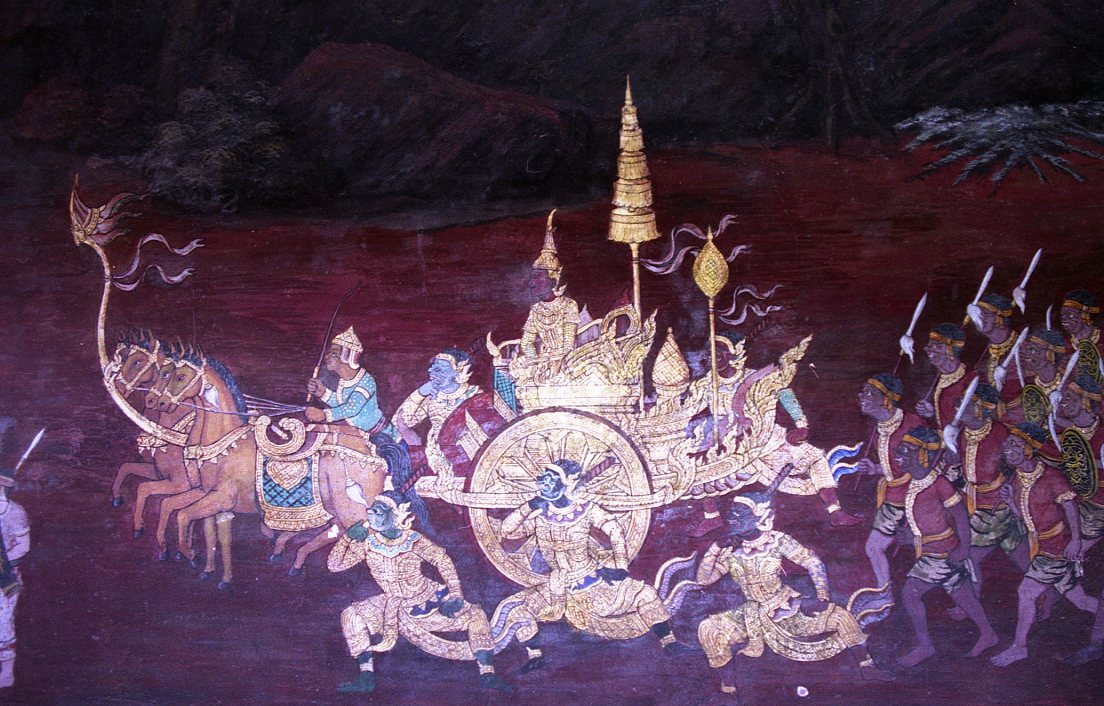 |
Photos |
| home | photos | travel | theatre | translations | computer | interests | contact |
Lightbox 2
|
Temples in Thailand, Vietnam, Laos and CambodiaIn most countries, historical buildings are in the majority of cases places of worship: in the west christian churches, in the east buddhist and hindu temples. I developed a particular liking for the remnants of long vanished cultures like the Cham in Vietnam, the Khmer in Laos, Thailand, and Cambodia. Here are some samples of photos taken in these temples...
                       Wat Phra Kaew is the main temple in Bangkok, in the same compound as the Royal Palace. It is a big tourist attraction, but also an important place of worship, in particular for the statue of the jade Buddha that resides in the main shrine (photo 1). This Wat is a labyrinth of shrines, stupas, galeries, etc. laden with gold, beautiful mosaics, impressive layered roofs with beautiful ornaments... The main part lies within a gallery that has the Ramakien* painted on its inside wall. The Royal Palace within the grounds looks a bit like Buckingham with tilted roofs. You can also take a look at the crockery and furniture of the Siamese kings. By the way: it is no coincidence that the Siamese kings adopted the ceremonial name of Rama... and Rama VI introduced the fork to Siam, that only knew spoon and knife till then (and chopsticks to eat noodles).
     The Ramakien is the Siamese version of the story of Rama (Ramayana*), the great Hindu epic about Prince Rama (Vishnu) and his brother Lakshmana pursuing the demon Ravana that has kidnapped Rama's beloved Sita (Lakshmi). With the help of the Ape King Hanuman they succeed in freeing Sita from the island (Sri) Lanka where Ravana kept her. Above are some scenes from the epic found in this gallery, whose paintings are probably constantly being restored.
             
                  Wat Pho is the oldest Buddhist temple in Bangkok, and also the one I like most. It is beautiful, well kept, but hasn't the posh side that goes with the Royal Phra Khaew temple. Furthermore, it is here that you can find the official Thai Massage School. Young people will do all kinds of things with your limbs and your back... and you'll feel much better afterwards. The main shrine in Wat Pho is that of the reclining Buddha, a 35 meter long golden sculpture, with mother of pearl for the feet and eyes. Bangkok boasts another giant golden Buddha, this time standing, at a Wat in the northern part of the city (near Dusit Zoo).
      My Son is probably the most important collection of temples of the Cham culture. Like the Khmer after them, they were influenced by the Hindu kingdoms on the island of Java. There are Cham temples to be found on the Vietnamese coast, like Po Nagar (at Nha Trang - last photo), but My Son lies a bit more inland and seems to have been an important settlement, with different compounds of temples. The place lies near Cat Tooth Mountain (in the back of the first photo), whose characteristic summit can be seen from different places along the coast. Archeological work at the site continues, but is hampered because My Son was heavily bombarded by the Americans during the Vietnam War. This war did more damage to the site than the 1000 years before it...
 1. 1.  2. 2.  3. 3.  4. 4.  5. 5.  6. 6.  7. 7.  8. 8.  9. 9.  10. 10.  11. 11.  12. 12.  13. 13.  14. 14.  15. 15. This is my favorite temple site... because of its beauty, its mysteries, but also because it was through a photo taken here that my beloved Touché found me! The origins of this shrine go back very far, probably a few millenia. It must have been a holy source (water springing from the living rock) and a fertility shrine (because the mountain top looks a bit phallic... the locals now call it irreverently Penis Mountain- photo 1). Different cultures that succeeded one another here, in the south part of Laos, on the right bank of the mighty Mekong, established important places of worship at this site. On the upper north side is a field with big boulders, of which two are of particular interest. In one is carved a crocodile (photo 5), in such a way that a human body could fit into it. It may have been used for human sacrifices... Nearby is another boulder with an elephant carved into it (photo 6). Right behind the small Hindu temple (photo 7) that marks the end of the steep ascend to the shrine (photos 3 & 4), there's another elephant carved in the vertical rock face, with a 1 sign (photo 8). More to the left is the original rock water source (photo 9). Right behind the temple the Trimurti, the Hindu trinity, is carved in the living rock (photo 10). The walls and lentils of the Hindu temple are all meticulously carved with guardians (photo 11), dancing girls (or Shiva's consort Parvati? - photo 12) and scenes from Hindu mythology (photo 13 & 14). At the foot of the 'pilgrimage stairs', there are two buildings that could have served as kind of a hostel (photo 15). There are also barays, water reservoirs, the like of which can be found near temples all over southern Asia. Finally, on the south side starts the road to Angkor... Wat Phou Champasak is today a Unesco World Heritage site, and much needed research and restoration has begun.
                            The best preserved Khmer temple complex outside Cambodia is Prasat Phimai in N.-E. Thailand. Phimai has kept the quadrilateral form of the ancient city, with city gates in north, south (Victory gate on the road to Angkor), west and east. The temple complex also is a square with a beautifully made tower as the central spot. Like most khmer temples outside Cambodia, Phimai was build before Angkor. In the later days of the Khmer culture, it shifted from Hinduism to Buddhism. Here also, the sculpture under the main tower is one of Buddha, while in one of the other towers stands a statue of one of the Khmer kings that built this complex. Just like Wat Phou, it is a shrine for Buddhists nowadays. Restoration is much more advanced than at other Khmer sites, but in the back there is still a collection of stones waiting to be reintegrated. Phimai has a good National Museum with more Khmer treasures. Further N.E. outside town, there is the One-Tree Forest, with a giant Golden Ficus tree (in fact it's a 'family' of trees). Inside is a shrine to the forest goddess (last photo), and soothsayers will tell you your future for a handful of baht.
          It's interesting to make a comparison between architecture of the 'lowland' Meuang Tam temple and that of the Phanom Rung complex that was built upon a hill standing on its own above the plain. Phanom Rung has the usual ascend with stairs and shrines, and is more vertical in general outlook, Meuang Tam is more spread out. Both are in N.-E. Thailand, between Phimai and the Cambodian border.
                       Preah Vihear is a Khmer temple complex on the Thai-Cambodian border, south of Ubon Thani, and really not far away from Wat Phou in Champasak or the other main remnants of Khmer culture outside Cambodia, Phanom Rung, Phimai and the like in N.E.-Thailand. There is at present a dispute between Thailand and Cambodia about the access to the site, which is much easier from across the Thai border than from inside Cambodia. It was another war victim, and unexploded bombs make the surroundings very dangerous. It is laid out as usual as a quite steep ascend with intermediate levels to the main shrine. In this case, this shrine lies on top of a cliff of a few hundred meters, in the middle of the wilderness. This complex is in a worse shape than any I visited in Laos or Thailand. Most buildings are badly damaged, either by erosion, by the invading wilderness, or by warfare. Preah Vihear is now also part of the Unesco World Heritage. |
||||||||||||||||||||||||||||||||
| home | photos | travel | theatre | translations | computer | interests | contact |





